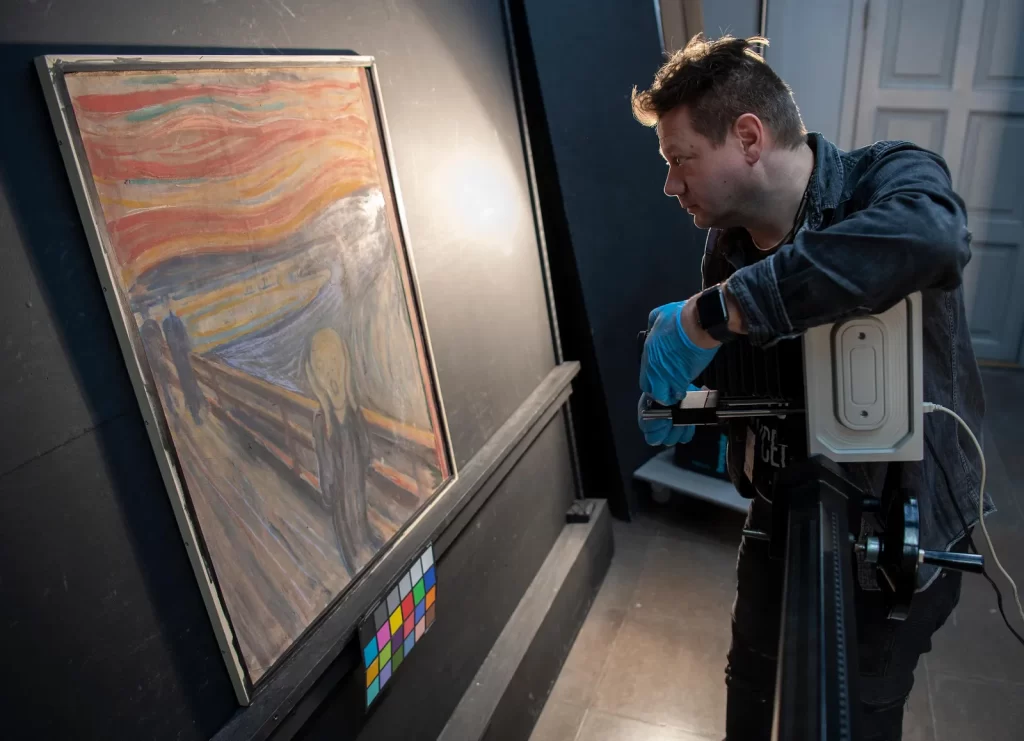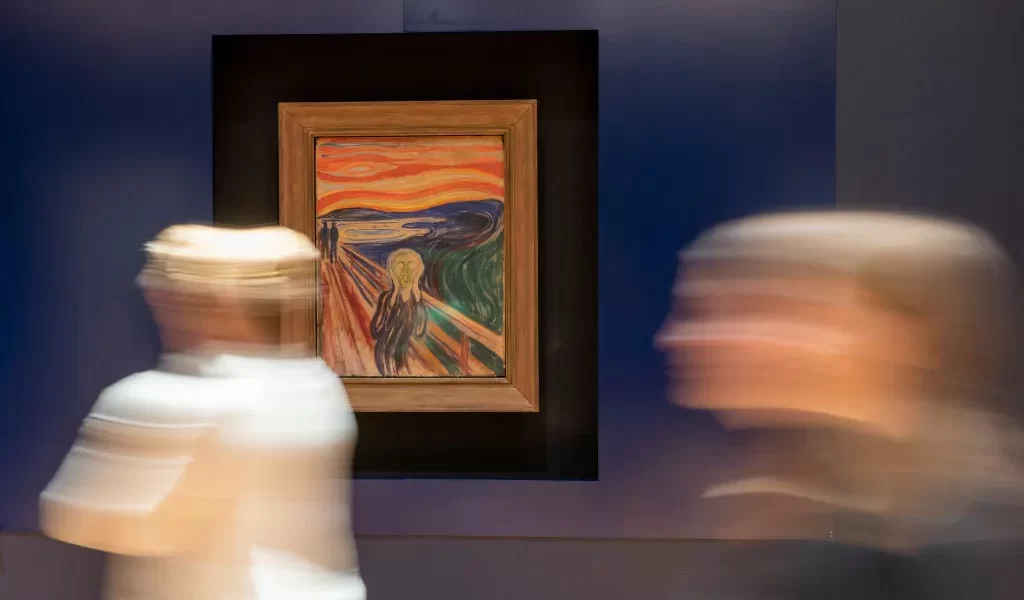In the late 19th century, the artistic landscape of Europe was undergoing a profound transformation. Amidst the rapid industrialization and urbanization that swept across the continent, a new generation of artists sought to break free from the constraints of traditional artistic norms. One such artist was the Norwegian painter Edvard Munch, whose seminal work, “The Scream,” would become an enduring symbol of the anxieties and existential crises that plagued the modern human experience.
Munch’s artistic journey was deeply influenced by the tumultuous social and political climate of his time. Born in 1863 in Løten, Norway, he grew up in a family haunted by mental illness, death, and the overwhelming pressures of a rapidly changing world. These formative experiences would later shape the emotional intensity and psychological depth that permeated his artistic oeuvre. As Munch once famously stated, “Illness, insanity, and death were the black angels that stood at my cradle.”
It was against this backdrop of personal and societal upheaval that Munch conceived of “The Scream.” Completed in 1893, the painting was part of a larger series titled “The Frieze of Life,” which explored the universal themes of love, fear, anxiety, and the human condition. Munch’s artistic vision was heavily influenced by the Symbolist movement, which emphasized the expression of subjective emotions and the exploration of the subconscious realm. This revolutionary approach to art would ultimately position Munch as a pioneering figure in the development of Expressionism, a movement that sought to convey the artist’s inner turmoil and psychological state through bold, distorted, and emotionally charged imagery.
Analysis of the artwork’s composition and style
At the heart of “The Scream” lies a haunting and iconic image that has captivated audiences for over a century. The painting depicts a solitary figure, seemingly androgynous, with a distorted, elongated face and a gaping mouth frozen in a primal scream. The figure is set against a swirling, undulating background of vibrant colors, creating a sense of overwhelming anxiety and unease.
Munch’s use of color and composition in “The Scream” is both striking and intentional. The predominant hues of orange, red, and pink create an atmosphere of intense emotional turmoil, evoking a sense of psychological and physiological distress. The sinuous lines and wave-like patterns that surround the central figure further heighten the sense of instability and disorientation, as if the very fabric of the world is unraveling around the protagonist.
The figure itself is rendered in a highly stylized and abstracted manner, with its elongated limbs and distorted features serving as a visual metaphor for the psychological and emotional anguish that the subject is experiencing. Munch’s use of expressive brushstrokes and bold, gestural lines lends a sense of raw, visceral energy to the painting, capturing the intensity of the scream and the overwhelming sensations that accompany it.
The symbolism and meaning behind “The Scream”
Beneath the striking visuals of “The Scream” lies a complex web of symbolism and meaning that reflects Munch’s deep engagement with the human condition. The central figure, with its gaping mouth and anguished expression, has been interpreted as a universal representation of the existential crisis that plagues the modern individual.
The scream itself, as the title suggests, is a primal expression of the human experience – a manifestation of the overwhelming anxiety, fear, and isolation that can consume the psyche. Munch’s own personal struggles with mental illness and the tragedies that plagued his life undoubtedly informed the emotional intensity and psychological depth of this iconic work. The figure’s solitary and detached stance, set against the swirling, chaotic backdrop, serves as a metaphor for the individual’s sense of alienation and disconnection from the world around them.
Moreover, the painting’s vibrant color palette and undulating lines can be seen as a visual representation of the sensory overload and psychological turmoil that the figure experiences. The warm, almost sickly hues of the sky and landscape evoke a sense of unease and discomfort, while the serpentine lines suggest the overwhelming nature of the emotional experience.
Ultimately, “The Scream” stands as a powerful testament to the human condition, capturing the universal anxieties, fears, and existential crises that haunt the modern individual. Munch’s ability to distill these complex emotional and psychological states into a single, iconic image has cemented the painting’s status as a timeless masterpiece of Expressionist art.
![]()
Munch’s inspiration and personal experiences
Edvard Munch’s artistic vision was deeply rooted in his own personal experiences and the tumultuous events that shaped his life. Born in 1863 in Løten, Norway, Munch’s childhood was marked by tragedy and mental anguish, which would later become the driving force behind his artistic exploration of the human condition.
Munch’s mother and sister both succumbed to tuberculosis when he was a young boy, leaving a profound impact on his psyche. The artist’s own struggles with mental illness, including depression and anxiety, further informed his artistic sensibilities and the emotional intensity that permeated his work. In his own words, Munch described the impetus behind his artistic journey, stating, “My art is the result of my life.”
The inspiration for “The Scream” can be traced back to a specific moment in Munch’s life, when he was walking along a path overlooking the Oslo Fjord. As he recounted in his journal, Munch was struck by a sudden and overwhelming sense of anxiety, describing the experience as “a great scream passing through nature.” This visceral encounter with the raw, primal emotions that can consume the human psyche would become the catalyst for the creation of his most iconic work.
Munch’s personal experiences and the tragedies that shaped his life were not merely the subject matter of his art but the very foundation upon which his artistic vision was constructed. By drawing from the depths of his own psychological and emotional turmoil, Munch was able to create works that resonated with the universal human experience, transcending the boundaries of time and culture.
The impact and legacy of “The Scream”
The enduring impact and legacy of “The Scream” can be seen in its widespread recognition and influence on the art world and popular culture. Since its creation in 1893, the painting has become an iconic symbol of the modern human condition, capturing the essence of the existential angst and psychological turmoil that plague the individual in the face of a rapidly changing world.
Munch’s masterpiece has been the subject of countless interpretations, analyses, and cultural references, solidifying its status as one of the most recognizable and influential works of art in history. From its inclusion in prestigious museum collections to its appearance in films, television shows, and commercial products, “The Scream” has transcended the boundaries of the art world and become a ubiquitous symbol of the human experience.
The painting’s impact can be attributed to Munch’s ability to distill complex emotional and psychological states into a single, powerful image. The figure’s distorted features and anguished expression have become a universal language, allowing viewers to project their own experiences of anxiety, fear, and existential crisis onto the canvas. This universal resonance has ensured that “The Scream” remains a touchstone of Expressionist art and a testament to the enduring power of visual storytelling.
Moreover, Munch’s influence can be seen in the work of subsequent generations of artists, who have drawn inspiration from the emotional intensity and psychological depth of his artistic vision. From the Surrealists’ exploration of the subconscious to the Expressionists’ focus on raw, visceral emotion, “The Scream” has left an indelible mark on the trajectory of modern and contemporary art.
Famous interpretations and parodies of “The Scream”
The enduring popularity and cultural significance of “The Scream” have led to a wealth of interpretations, analyses, and parodies that have further cemented the painting’s status as an iconic work of art. From scholarly examinations of its symbolic and psychological depth to playful reimaginings in popular culture, the legacy of Munch’s masterpiece continues to evolve and expand.
One of the most notable interpretations of “The Scream” comes from the renowned art historian Reinhold Heller, who posited that the painting’s central figure represents a universal archetype of the modern individual, struggling to find meaning and connection in a rapidly changing world. Heller’s analysis delves into the painting’s symbolic language, exploring the ways in which Munch’s use of color, composition, and expressive brushwork serve as a visual metaphor for the psychological and emotional turmoil of the human experience.
In the realm of popular culture, “The Scream” has been the subject of countless parodies and reinterpretations, further solidifying its status as a cultural touchstone. From the iconic “Scream” mask, which has become a staple of Halloween costumes and horror movie iconography, to the countless memes and satirical references that have proliferated across the internet, Munch’s masterpiece has become a ubiquitous presence in contemporary visual culture.
The versatility and enduring appeal of “The Scream” have also led to its inclusion in various artistic and commercial ventures, from high-profile museum exhibitions to collaborations with fashion and design brands. These diverse interpretations and appropriations of Munch’s work serve as a testament to the painting’s ability to transcend the boundaries of the art world and resonate with audiences across a wide range of cultural and social contexts.

Munch’s other notable works
While “The Scream” remains Edvard Munch’s most iconic and widely recognized work, the artist’s oeuvre is rich with a diverse array of paintings, prints, and drawings that explore the complexities of the human condition. Throughout his prolific career, Munch’s artistic vision was consistently shaped by his personal experiences, his engagement with the psychological and emotional depths of the human psyche, and his exploration of the universal themes that define the human experience.
One of Munch’s other notable works, “The Kiss,” is a powerful exploration of the intertwined nature of love, desire, and anguish. Depicting a couple locked in a passionate embrace, the painting is characterized by a similar expressionistic style and vibrant color palette that defines Munch’s artistic signature. The figures’ distorted features and the swirling, undulating background serve to convey the intensity and complexity of the emotional experience, reflecting Munch’s belief that love and suffering are inextricably linked.
Another significant work in Munch’s oeuvre is “The Sick Child,” a poignant and deeply personal painting that reflects the artist’s own experiences with the loss of his mother and sister. The painting’s subdued color palette and somber, introspective mood evoke a sense of profound grief and melancholy, capturing the emotional turmoil that accompanies the loss of a loved one. Munch’s ability to imbue his work with such raw, emotional intensity is a testament to his skill as a master of psychological and emotive expression.
Throughout his career, Munch’s artistic vision continued to evolve, with the artist exploring a wide range of media, including printmaking, sculpture, and even photography. However, his paintings remained the cornerstone of his artistic practice, serving as a vehicle for his exploration of the human condition and the universal themes that define the human experience. From the haunting, visceral energy of “The Scream” to the intimate, introspective nature of “The Sick Child,” Munch’s body of work stands as a testament to the enduring power of art to capture the complexities of the human psyche.
Exhibitions and museums showcasing “The Scream”
The enduring legacy and cultural significance of Edvard Munch’s “The Scream” have led to its inclusion in numerous prestigious exhibitions and museum collections around the world. As one of the most iconic and recognizable works of art in history, the painting has been the subject of countless curatorial and scholarly examinations, each offering new perspectives on its enduring impact and relevance.
One of the most notable exhibitions featuring “The Scream” was the 2012 retrospective “Edvard Munch: The Modern Eye” at the Tate Modern in London. This landmark exhibition brought together a comprehensive selection of Munch’s works, including several versions of “The Scream,” and explored the artist’s innovative use of various media, his engagement with the emerging technologies of his time, and the ways in which his artistic vision continued to evolve throughout his prolific career.
Another significant exhibition that showcased the power and significance of “The Scream” was the 2019 exhibition “Munch and the Modern Mind” at the National Museum of Norway in Oslo. This exhibition delved into the psychological and emotional depth of Munch’s artistic vision, exploring the ways in which his personal experiences and engagement with the human condition informed the creation of his most iconic works, including the haunting and unforgettable oppatoto.
In addition to these high-profile exhibitions, “The Scream” can be found in the permanent collections of several of the world’s most prestigious art museums, including the National Gallery in Oslo, the Munch Museum in Oslo, and the Museum of Modern Art in New York City. These institutions have played a vital role in preserving and promoting the legacy of Munch’s masterpiece, ensuring that it continues to captivate and inspire audiences for generations to come.
The enduring relevance of “The Scream” in art history
Over a century after its creation, Edvard Munch’s “The Scream” remains a seminal and enduring work of art, a testament to the power of visual expression to capture the complexities of the human experience. As a symbol of the anxieties, fears, and existential crises that plague the modern individual, the painting has transcended the boundaries of the art world to become a cultural touchstone, resonating with audiences across time and space.
Munch’s ability to distill the raw, primal emotions of the human psyche into a single, iconic image has cemented the status of “The Scream” as a masterpiece of Expressionist art. Through his bold, expressive brushstrokes, vibrant color palette, and distorted, abstracted forms, the artist has created a work that speaks to the universal human condition, inviting viewers to project their own experiences of psychological and emotional turmoil onto the canvas.
The enduring relevance of “The Scream” can be seen in the countless interpretations, analyses, and parodies that have emerged over the years, each offering a unique perspective on the painting’s symbolic and psychological depth. From scholarly examinations of its artistic and cultural significance to its ubiquitous presence in popular culture, Munch’s masterpiece has become a touchstone for the exploration of the human condition, a visual manifesto of the anxieties and existential crises that define the modern experience.
As we continue to grapple with the complexities and challenges of the contemporary world, the timeless power and relevance of “The Scream” endure. Munch’s iconic work stands as a testament to the transformative potential of art, a reminder that the act of visual expression can serve as a powerful tool for the exploration and understanding of the human experience. In the face of the overwhelming anxieties and uncertainties that define our era, “The Scream” remains a beacon of artistic and cultural significance, a timeless masterpiece that continues to captivate and inspire audiences around the world.
Also read: 1984: The Dystopian World of George Orwell and Its Timeless Relevance











